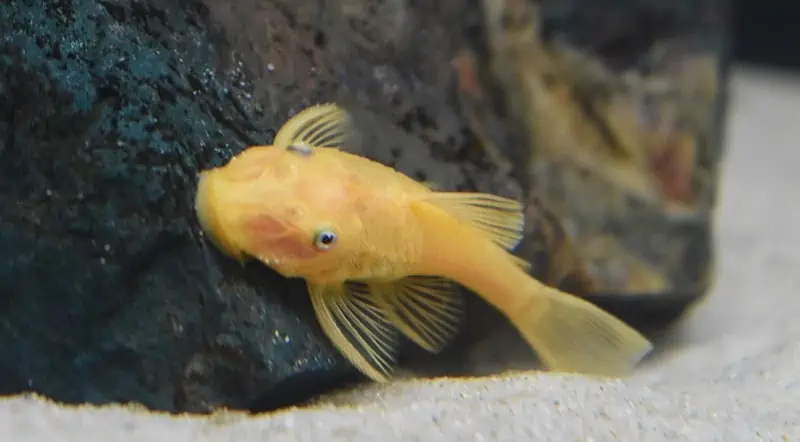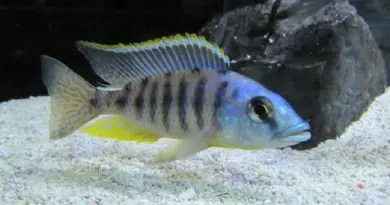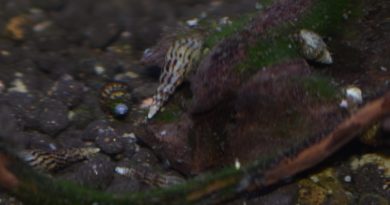Best Algae Eater for an African Cichlid Tank
Keeping algae eaters with African cichlids is a fantastic combination when it works. In the ideal scenario, the algae eater will help to keep the tank looking nice and clean but won’t get harassed too much by the aggressive cichlids.
Bristlenose plecos are a great choice of algae eater for an African cichlid tank. They are non-stop algae eaters which do an amazing job of keeping the rocks and glass free of algae. They also stay on the smaller side at around 5 inches.
Not all plecos are efficient algae eaters, some grow too big, or require a completely different tank setup to be housed with African cichlids. In this article, we’ll explore some of the reasons why out of the huge selection of algae eaters, Bristlenose plecos are the best option.
Why you should keep an algae eater in your African cichlid tank
To start let’s look at the reasons why you should keep an algae eater in your African cichlid tank.
- To help keep the rocks and glass clean of algae.
- You like the look of the pleco
Keeping the aquarium free of algae is the main reason that most people have for keeping a pleco in any aquarium. African cichlid tanks usually contain a lot of rock work which can be back-breaking work to keep clean. Having a fish to help you keep the rocks clean is a huge benefit.
Plecos are a very unique fish that adds a nice relaxing element to your cichlid aquarium as they make their way around the tank cleaning algae off the surfaces.
Why is a Bristlenose Pleco the best algae eater for an African cichlid tank?
Here are some of the reasons why a Bristlenose pleco is the ideal algae eater for an African cichlid tank.
- Efficient at clearing algae
- Max size of around 5 inches
- Contribute less to the bioload of the tank than a larger pleco.
- Usually ignored by African cichlids
Different types of Bristlenose plecos
Although we have shortlisted our options to Bristlenose plecos (Ancistrus species) there are still a few types for us to choose from. Below are my recommendations as I have kept these types of Bristlenose pleco successfully with African cichlids.
I prefer to stick with the dark color Bristlenose plecos. They tend to draw less attention from the cichlids than the lighter color variety. Additionally, you will want to avoid any of the longfin types of Bristlenose or those with blue or red eyes which the cichlids will try to nip at.
Common Bristlenose pleco (Ancistrus cirrhosus / sp 3)
The common Bristlenose is my preferred choice of pleco for an African cichlid tank. They are tirelessly working away in the background to keep your tank free of algae. The brown color of the pleco doesn’t draw any attention from the cichlids.
The adult size of the Common Bristlenose pleco is around 5 inches. Not to be confused with the Common pleco which has an adult size of 16 inches. In addition to their massive size, Common plecos don’t eat much algae as they get older.
There is an albino version of the Common Bristlenose pleco available. It’s a great looking fish but I have noticed cichlids trying to nip at its red eyes on several occasions.
Adult Size: 5 inches
You can find more information and photos of the Common Bristlenose Pleco on the Planet Catfish website.
Starlight Bristlenose (Ancistrus dolichopterus / L183)
This is my favorite of all the Bristlenose species. When young they are a beautiful black fish with large white spots on the body with a thick white seam along the dorsal and tail fins. As they mature the white seams on the fins will disappear and the spots get smaller. Nevertheless, they remain a fantastic looking fish.
Although Starlight Bristlenose prefer a low ph, they can be an option if the ph of your tank is around the neutral range and they are slowly acclimatized.
Adult Size: 4.6 inches
You can find more information and photos of the Starlight Bristlenose Pleco on the Planet Catfish website.
Black Eyed Yellow Bristlenose Pleco (sp 4 / False L144)
While it doesn’t have the dark body I usually look for in a pleco for an African cichlid tank, I have gotten away with the Yellow Bristlenose plecos in my grow out tanks.
There is also a long fin type and a blue-eyed type of L144.
Adult Size: 4.5 inches
You can find more information and photos of the Black Eyed Yellow Bristlenose Pleco on the Planet Catfish website.
You can view a full list of Bristlenose plecos at the Planet Catfish catalogue.
Bristlenose pleco care in an African cichlid tank
The majority of plecos, including Bristlenose, prefer a tank with soft water, a low ph, and plenty of driftwood for them to chew on. They can adapt well to life in an African cichlid tank but there are some considerations.
Bristlenose plecos need more food than just algae to live off. Feeding with a good quality algae wafer after lights out is recommended. Another option is a piece of cucumber weighted down and tied to a piece of string. The cucumber is lowered down into the tank using the string at night time and removed in the morning.
Driftwood helps with digestion and I like to keep a small piece of driftwood hidden in the rocks, out of sight but there for the pleco to eat on.
Keep an eye on your pleco. If you notice that it’s starting to show signs of sunken stomach move it to a quarantine tank and fatten it up for a couple of weeks while waiting for the algae to build up again in your main tank.
The work rate of a Bristlenose pleco is incredible and a single pleco is usually more than enough for any tank.
No thanks! Bristlenose plecos freak me out. Is there another option?
Rubberlip pleco (Chaetostoma formosae L444 / L187b)
The Rubberlip pleco Chaetostoma formosae (L444 / L187b) is another good option to keep with African cichlids. It goes by quite a variety of common names such as Rubberlip pleco, Rubbernose pleco and Striped Bulldog pleco. If you’re not a fan of Bristlenose plecos a Rubberlip may be just what you are looking for.
Rubberlip pleco pros:
- Prettier looking than Bristlenose
- Efficient at clearing algae
- Max size of around 5 inches
- Contribute less to the bioload of the tank than a larger pleco.
- Usually ignored by African cichlids
- Prefer a higher PH and water hardness than other plecos
- Don’t require driftwood in their diet.
Rubberlip pleco cons:
- May not accept algae wafers
- Not as hardy as Bristlenose plecos
You can find more information and photos of the Rubberlip Pleco on the Planet Catfish website.
Conclusion
Keeping a pleco in an African cichlid tank is a great way to keep algae under control. Personally, I would much rather vacuum and water change waste out of the aquarium than spend hours scrubbing algae of rocks.
A Bristlenose pleco is your best friend in that regard. Make sure to take good care of it and feed it properly once all the algae is gone.
Thanks for reading. If you found this article helpful, don’t forget to share 🙂



